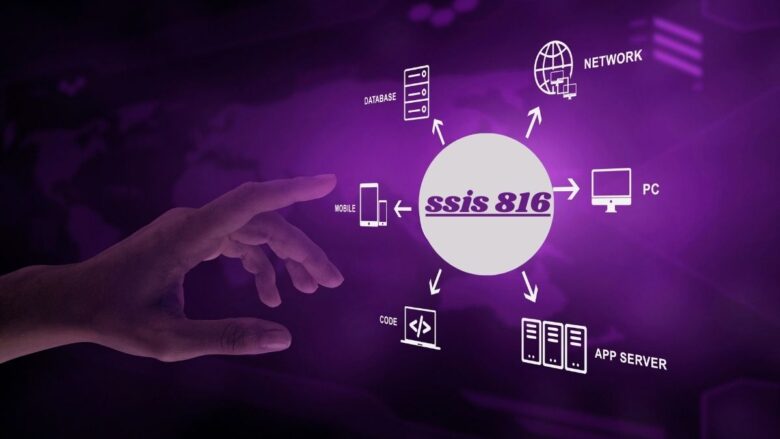ssis 816 Microsoft created SQL Server Integration Services (SSIS), a potent tool for data integration. It helps users to efficiently carry out a variety of data migration, transformation, and management operations. SSIS is essential to today’s data-driven enterprises because it makes data transfer across several platforms and systems smooth.
Understanding SSIS 816
The most recent version of SQL Server Integration Services, known as SSIS 816, is brimming with cutting-edge features and improvements. The purpose of this SSIS version is to meet the changing requirements of data professionals managing intricate data integration scenarios. It provides strong processing power for massive data sets, guaranteeing scalability and excellent performance.
SSIS 816’s ability to efficiently streamline the ETL (Extract, Transform, Load) process is one of the main factors contributing to its popularity. This process enables enterprises to effectively extract useful insights from their data assets. SSIS 816 offers the features and tools required to facilitate the completion of complex transformations and the seamless integration of data from many sources.
Features of SSIS 816
SSIS 816 has many capabilities that enable users to effectively address a variety of data integration difficulties, including:
Data Integration:
SSIS 816 provides extensive assistance with combining data from multiple sources, such as cloud-based platforms, flat files, and databases. To enable seamless data mobility across various contexts, it offers robust data transformation capabilities along with customizable connectivity options.
Advanced Transformations:
With SSIS 816, users can leverage advanced transformations to manipulate and enrich their data according to specific business requirements. From simple tasks like filtering and sorting to complex operations such as data cleansing and deduplication, SSIS provides a rich set of transformation components to facilitate these processes.
ssis 816 Scalability:
SSIS 816 is built to easily scale to manage massive data volumes and meet expanding business requirements. To address the needs of enterprise-scale data integration projects, SSIS can expand both horizontally and vertically, handling tasks like processing millions of records or coordinating intricate data workflows.
Performance Optimization:
SSIS 816 places a lot of emphasis on performance optimization, offering a number of features that should increase processing power and speed. SSIS offers multiple optimization approaches to provide optimal performance in diverse settings, ranging from in-memory data processing capabilities to parallel job execution.
How to Get Started with SSIS 816
Because of SSIS 816’s user-friendly interface and extensive documentation, getting started with it is not too difficult. Here is a step-by-step tutorial to get you started with SSIS 816:
Installation Process:
Start by getting SQL Server Integration Services from the official Microsoft website and installing it. Configure SSIS on your system by following the installation wizard’s instructions.
Setting Up Environment:
To enter the SSIS development environment after installing SSIS , open SQL Server Data Tools (SSDT) or SQL Server Management Studio (SSMS). Within the SSIS project, configure the connections that are required to your data sources and destinations.
ssis 816 Creating Your First Project:
In the development environment, start a new SSIS project and specify the data integration tasks needed for it. Design data flow pipelines with the drag-and-drop feature, adding different transformations as needed.
Best Practices for Using SSIS 816
Even though SSIS has strong data integration and management capabilities, maximizing its efficacy and efficiency requires adhering to best practices. Taking into account the following best practices when utilizing SSIS 816:
ssis 816 Data Flow Optimization:
To reduce latency and increase throughput, optimize data flow pipelines. To improve performance, make use of effective data transformation strategies and, when practical, parallel execution.
Error Handling:
To handle errors gently and maintain data integrity, implement strong error handling procedures. Make use of SSIS integrated error handling capabilities, like event handling and error redirection, to efficiently handle mistakes during data processing.
Logging and Auditing:
To keep track of data integration processes and track performance metrics, enable the logging and auditing options in SSIS . Set up logging options to record pertinent data for troubleshooting, such as package execution, problems, and warnings.
Common Challenges with SSIS 816
While SSIS offers significant advantages in data integration and management, users may encounter certain challenges during implementation and usage. Here are some common challenges associated with SSIS 816:
Compatibility Issues:
Compatibility issues may arise when integrating SSIS with other systems or platforms. Ensure that all components and dependencies are compatible with the chosen SSIS version to avoid compatibility issues.
Performance Bottlenecks:
Performance bottlenecks can occur due to inefficient data processing logic, resource constraints, or infrastructure limitations. Identify and address performance bottlenecks through performance tuning and optimization techniques.
Maintenance Complexity:
Managing and maintaining SSIS 816 packages and configurations can become complex, especially in large-scale deployment scenarios. Implement robust maintenance practices and automation solutions to streamline package management and administration tasks.
ssis 816 Tips for Maximizing Efficiency
To maximize efficiency and performance in SSIS 816, consider implementing the following tips and best practices:
Utilizing Parallelism:
Leverage parallel execution features in SSIS to distribute data processing tasks across multiple threads or servers. Parallelism can significantly improve processing speed and throughput, especially for large-scale data integration projects.
Implementing Incremental Loads:
Instead of processing entire datasets every time, implement incremental loading techniques to only process incremental changes or updates. This can reduce processing time and resource overhead, especially for datasets with frequent updates.
Regular Monitoring and Maintenance:
Establish a proactive monitoring and maintenance routine to ensure the optimal performance and reliability of SSIS 816 packages. Monitor system resources, performance metrics, and job execution logs regularly to identify any issues or anomalies proactively.
ssis 816 Case Studies
To illustrate the real-world impact and effectiveness of SSIS , let’s explore a couple of case studies showcasing successful implementations:
Retail Analytics:
A leading retail organization leveraged SSIS to integrate data from multiple sales channels, including online stores, brick-and-mortar outlets, and third-party vendors. By streamlining the data integration process and implementing advanced transformations, the organization was able to gain actionable insights into customer behavior, inventory management, and sales performance, leading to improved decision-making and operational efficiency.
Healthcare Data Integration:
A healthcare provider utilized SSIS 816 to integrate disparate healthcare data sources, including electronic health records (EHR), medical imaging systems, and billing platforms. By automating data integration tasks and ensuring data consistency and accuracy, the healthcare provider enhanced patient care delivery, streamlined administrative processes, and facilitated regulatory compliance.
Future Trends in SSIS 816
Looking ahead, SSIS is poised to evolve further to meet the evolving demands of the data integration landscape. Some future trends and developments to watch out for include:
Integration with Cloud Technologies:
SSIS is expected to enhance its integration capabilities with cloud-based platforms and services, enabling seamless data movement between on-premises and cloud environments. This will facilitate hybrid data integration scenarios and support organizations’ migration to the cloud.
Automation and AI Integration:
Integration of automation and artificial intelligence (AI) capabilities within SSIS will enable users to automate repetitive tasks, optimize data workflows, and derive actionable insights from data automatically. AI-driven data integration and processing will enhance efficiency, accuracy, and scalability in SSIS deployments.
Conclusion
In conclusion, SSIS 816 is a powerful data integration tool that offers advanced features and capabilities to streamline the ETL process, enhance performance, and support complex data integration scenarios. By following best practices, addressing common challenges, and leveraging optimization techniques, organizations can maximize the efficiency and effectiveness of SSIS in their data integration initiatives. As SSIS continues to evolve and embrace emerging technologies, it will remain a key component in the data integration toolkit of modern enterprises.
Also Visit:
Techy Hit Tools: Boosting Your SEO Game
READ MORE : Understanding EasyGo Entertainment Pty Ltd’s Net Worth.




